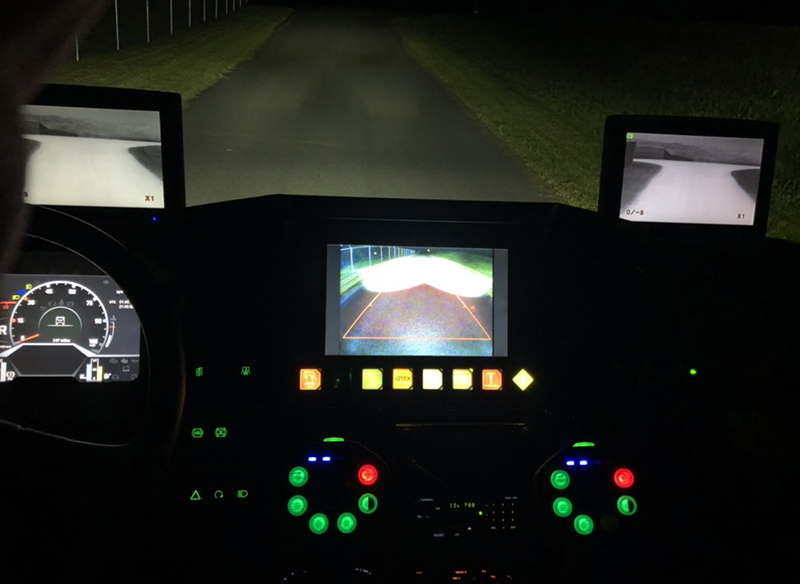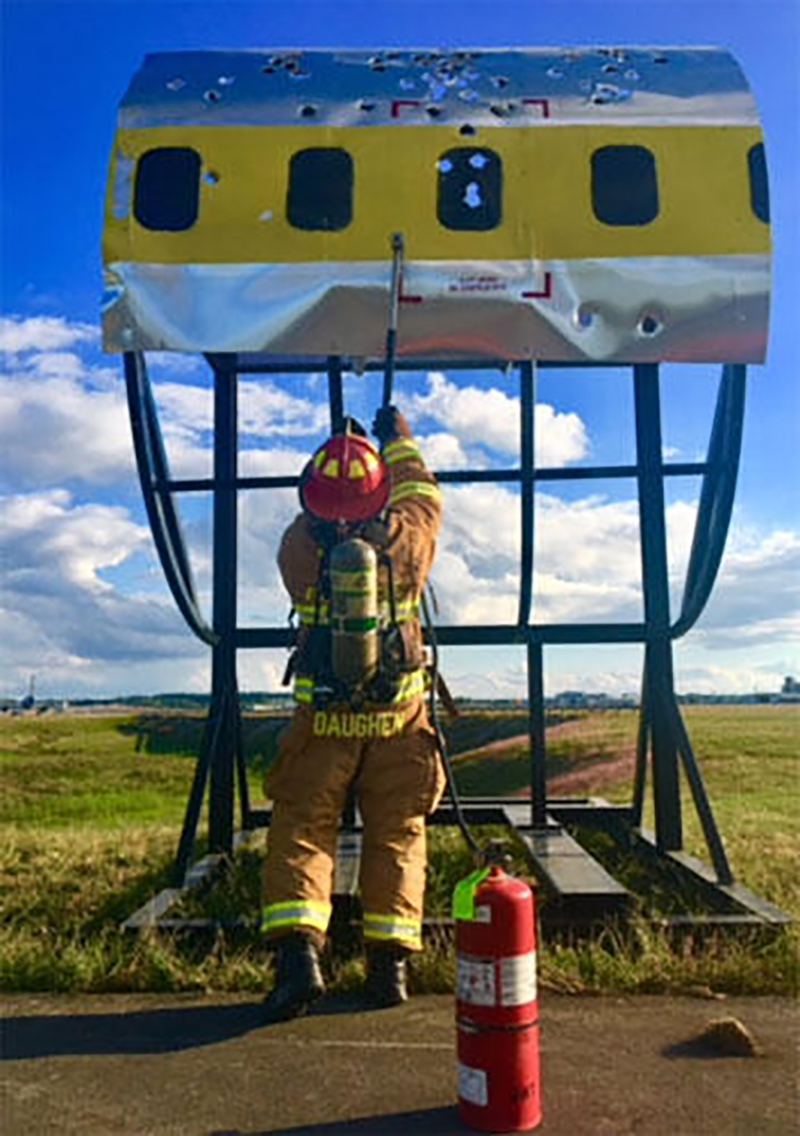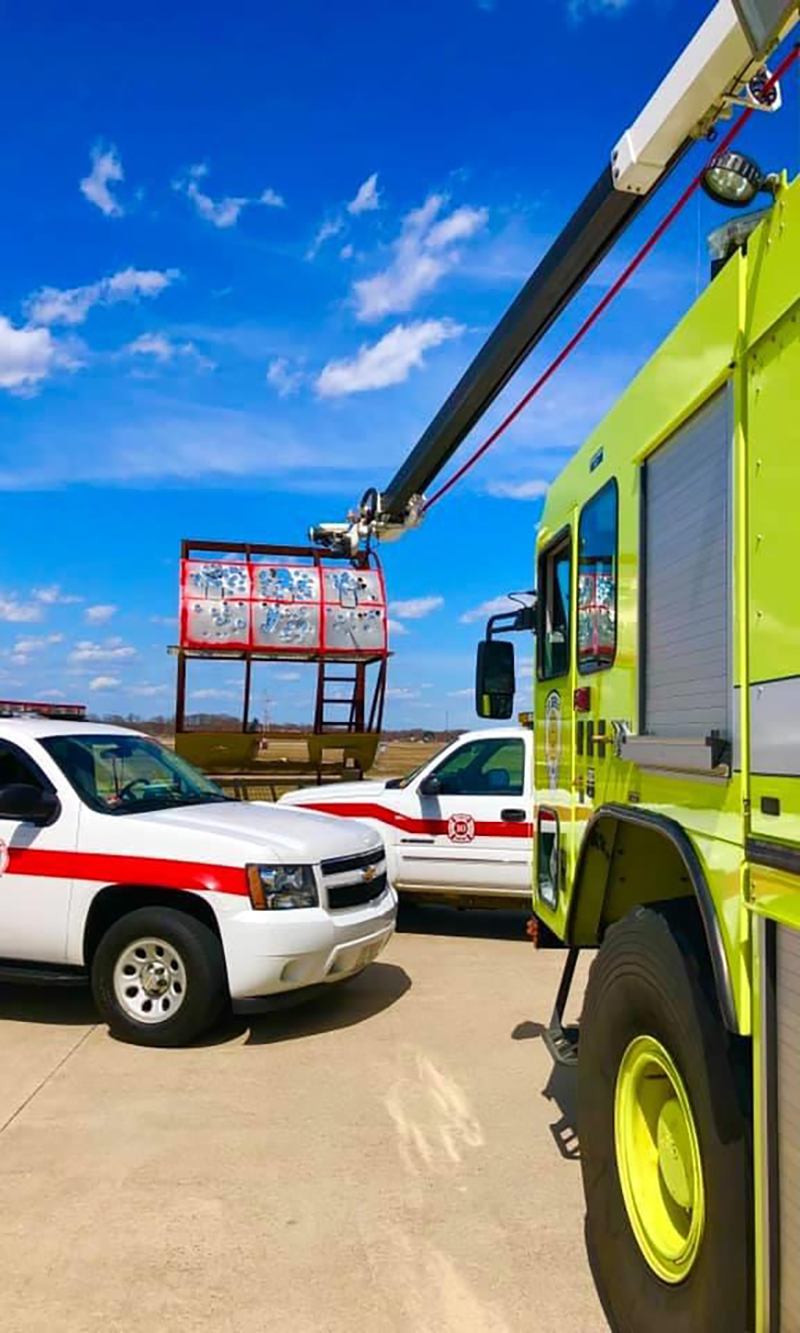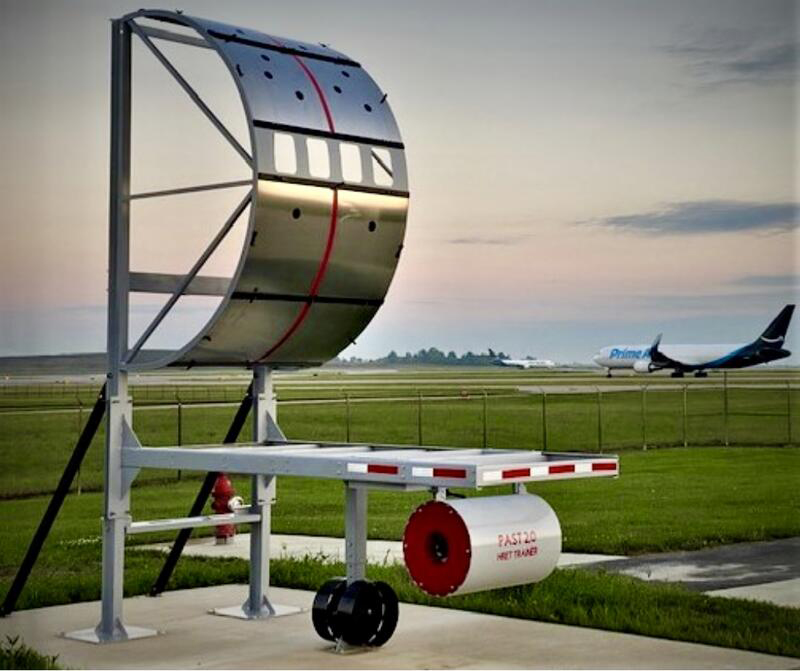By William Greenwood
With the advent of the thermal imaging camera (TIC), technology has given us the ability to see again.
That alone is an amazing feat and provides an increased level of safety. But, as with any technology, it also comes with challenges that some operators might not know about. We all know and understand how important a TIC is during a structure fire. But, what about using a TIC to during an aircraft emergency?
THE ARFF MISSION
The core foundation or mission of the aircraft rescue and firefighting (ARFF) team is to protect the flying public. There is no better opportunity to increase those services than to embrace modern technology in ARFF.
Depending on the specific mission at your airport, this is what really drives your risk management model. For example, fire departments that provide only flight-line fire protection should primarily focus their training on the tactics used for responding to aircraft emergencies and fires. ARFF departments that provide both flight-line and structural protection must provide training for both target hazards.
THE ADVANTAGES OF THE TIC
The advantages of using a TIC are obvious. They allow the user to locate the fire or victims faster than without one. In the ARFF industry, there are some challenges not commonly found when fighting a structure fire. These challenges include the fuels that are burning, the aircraft construction (materials), and with that some incredibly high temperatures created by the materials burning on an aircraft. But, with a solid training program, the TIC can be a very effective tool when used in the ARFF industry.
TIC USE FOR ARFF
Firefighting crews can use the TIC to assist in emergency response in low-visibility conditions. Vehicle-mounted cameras provide the driver-operator with the ability to see through darkness, rain, fog, and smoke. Depending on the type and where the camera is mounted, the driver-operator must be able to train with the technology before an emergency happens. Challenges are often found with depth perception and the ability to identify spatial awareness. Providing ARFF driver-operators with an opportunity to operate these big, oversized fire apparatus in similar adverse weather conditions will benefit response on game day. On arrival at the incident scene, the TIC can also afford the driver-operator with information on the location of the fire, which emergency egress exits are in operation, and where all the people who have evacuated the aircraft on the exterior are.
This information, in conjunction with a portable penetrating piercing nozzle, or high reach extendable turret (HRET), can allow rapid and precise fire attack. The TIC can also assist interior search and rescue firefighters with locating victims, finding the seat of the fire, and assisting with locating hidden fires both during extinguishment and also during overhaul. Aircraft have many voids and hidden spaces where heat, smoke, and fire can travel. Additionally, the TIC can be used for locating overheated electrical components, monitoring hot brake incidents, and locating invisible high-pressure hydraulic cylinder leaks and potentially dangerous liquid oxygen (LOX) leaks on military aircraft systems.
TIC CHALLENGES
There are a few challenges that ARFF personnel may face when using a TIC during an aircraft incident. Aircraft construction is made up of a variety of aluminum, duralumin, composites, magnesium, titanium, and steel. Aircraft skin can have a blend of aluminum alloys to form lightweight panels that have rigidity. The panels are known to have relatively low emissivity. When interpreting an image with a TIC during low emissivity, it doesn’t read true temperatures. The LCD can show these materials as black or even gray. Don’t be fooled by the palette displayed (heat signature) because these have been known to be hotter than traditional black or gray materials in the structural firefighting world.
TICs can also display images on shiny objects like a mirror or glass, and polished aluminum could present a challenge. In these TIC presentations with the reflection of infrared (IR), firefighters need to understand that the images viewed may not be the true layout because reflections of fire, access, egress of doors and windows, or even victims seen by the camera might not be accurate.
TIC TALK TRAINING
Developing a good TIC training program has to take into consideration the intended working environment. As a professional educator, one of my goals is to always train firefighters for the environment they are expected to work in. Training inside the fire station with the lights off to replicate how the camera will display is highly inefficient. The sensitivity from the different building materials and the climate-controlled environment are just a few issues that will train firefighters for what they likely won’t see. Training firefighters for TIC use and operations at some of the Federal Aviation Administration (FAA) approved training facilities for interior fire operations can also create some unique challenges as well. The density of the materials used to build and sustain repetitive live-fire evolutions will also change the sensitivity of the display. Many of these props are made with very thick and heavy steel plates and tubes, unlike the lighter materials used in the aviation industry.
Therefore, we must gain access to true aviation materials to introduce and train firefighters on the cause and effect of TIC sensitivity. The fixed and mobile training facilities do provide realistic training, however, on just how small and compact our working environment truly is. Access and egress doors, windows, and hatches are smaller than traditional residential construction found in our homes. Aircraft aisles or walkways are also very narrow and sometimes may require firefighters to modify the way they ergonomically move their bodies with full personal protective equipment (PPE) and self-contained breathing apparatus (SCBA). The TIC provides us with the ability to see through thick, dense, black smoke. Practical applications in aircraft not only allow users to look down these narrow aisles but also allow them to look underneath the seats to locate potentially unconscious or incapacitated victims quickly. From a given position, you can see a good five to 10 rows, depending on the amount of carry-on baggage placed on the floor. The best training application is to gain access to both the commercially built live fire trainers and real-world aircraft. This will allow the user to see the differences in heat, smoke, and gases along with the lightweight density and sensitivity of a real aircraft.

1 A Rosenbauer Panther dashboard outfitted with a roof-mounted TIC for low-visibility response and aircraft size-up. (Photos courtesy of FETC Services unless otherwise noted.)
PENETRATING NOZZLES
Compartmentalized fires in the ARFF industry can range from fires involving larger cargo holds and cargo shipping containers to the smaller and limited access areas of the interior lavatory, cabinets, food service galley, and many other hidden void spaces within the structural members of the aircraft itself. These types of fires are all good examples of when using a penetrating nozzle can be applied in limited access areas. Many larger ARFF departments have vehicle-mounted HRETs, but for the smaller commercial and general aviation airports that don’t have these types of vehicles, a portable penetrating tool might be the quick and inexpensive answer.
A small penetrating nozzle can safely and efficiently suppress many types of compartmentalized fires using an indirect method of attack. These penetrating tools connect directly to a portable fire extinguisher of your choice. Photo 2 shows it attached to a 20-pound extinguisher. This application allows the delivery of the extinguishing agent with the benefit of a weighted penetrating nozzle. The tool we use weighs about 12 pounds; the handle is wrapped in foam and is a little more than 30 inches long. The nozzle was designed with a flat surface on the backside of the tip to allow it to be driven with a striking tool like a flathead ax or sledgehammer. The nozzle is a multipurpose tool that not only extinguishes aircraft compartment fires but can be used on motor vehicle engine and passenger compartment fires.
CONSIDERATIONS FOR USE
Best practices have yielded large successes in confirmed hidden void fires that were closed up and starting to become underventilated. In our applications during live-fire training evolutions, the tool provided a rapid application of extinguishing agent while additional personnel on the scene were setting up for a traditional entry or opening up with cutting equipment. The benefit of rapid application is reducing potential backdraft or rapid fire increase when the compartment is opened to the atmosphere. Therefore, operating the penetrating nozzle through the compartment door, exterior panel, or cargo container prior to opening the access door reduces additional property loss with uninterrupted free burning fire.

2 Single-firefighter application of a portable piercing tool.

3 Tactical positioning of the HRET for fire attack with obstructions.

4 The latest Elevating PAST 2.0. (Photo courtesy of Airport Professional Services, LLC.)
OPERATING THE TOOL
Firefighters should always be wearing full PPE and SCBA for protection from heat, smoke, and toxic gases. Prior to approaching the scene, a firefighter must perform a size-up, identifying the location and seat of the fire. Firefighters can use a TIC to determine the exact location of hidden fire. Extinguishing agent applied to areas other than the seat of the fire will not have the same impact for extinguishment. By using the heat signature depicted on the TIC to determine your penetrating point, the firefighter can then access the compartment with the portable piercing tool to apply and discharge extinguishing agents through the tool’s handle and specially designed nozzle.
STEPPING UP YOUR HRET TRAINING
Many commercial airports have a vehicle-mounted HRET. With the ARFF industry seeing a lot of turnover post-COVID similar to our structural counterparts, I want to review where HRETs originated and how we can advance HRET training for the senior members.
The first HRET piercing nozzle was delivered in 1987 to the Phoenix (AZ) Airport Fire Department. The idea was to mount a piercing nozzle on the end of an extendible turret articulating boom. At that time, many airports were using the skin penetrator agent applicator tool (SPAAT). There were several challenges associated with handheld skin penetration of an aircraft. When drilling through the outer skin, the bit would get wound up in the insulation material and prevent the drill from easily entering the aircraft, hence the need to develop the HRET-mounted piercing nozzle.
In 1991, extensive testing was conducted in Charlotte, North Carolina, at an aircraft boneyard. At that time, every flying commercial aircraft was tested to see if the boom-mounted piercing nozzle could handle the task. The benchmark for testing was the DC-8. Its construction process was vastly different from many other commercial aircraft. In particular, the windows were integrated on the exterior of the aircraft as opposed to being clipped on the inside like today’s commercial aircraft. The HRET-mounted piercing nozzle not only penetrated the aircraft skin but was also able to penetrate through the thick windows.
During that time, the FAA Fire Research Center was conducting tests with the SPAAT. The FAA reviewed the HRET testing data from Charlotte, and it became clear they needed to have one of its research vehicles retrofitted with an HRET to conduct a battery of tests and validation. The FAA conducted real-world tests and evaluation in San Antonio in 1994. A Boeing 720 was fully instrumented with thermal couplers throughout the interior of the aircraft to monitor temperatures, the effectiveness of the spray pattern, and fire extinguishment.
At that time, the HRET was not considered within the FAA Advisory Circular or National Fire Protection Association (NFPA) 414, Standard for Aircraft Rescue and Fire-Fighting Vehicles, as a replacement for the standard roof-mounted turret. From 1991 to 1995, extensive testing was conducted with the HRET and piercing nozzle. One of the final validation tests was conducted at the Air Force Fire Research Center at the Tyndall Air Force Base. The test protocol was a 1,000-gallon spill pit fire with a standard P-19 ARFF vehicle with a roof turret and the FAA research vehicle outfitted with an HRET. The vehicles had set requirements: Both vehicles flowed 500 gallons per minute at a fixed position on the nose of the aircraft under the most adverse conditions.
The results of the side-by-side tests were quite impressive. The HRET was officially introduced into the Appendix of NFPA 414 (1995 ed.) and was brought forward in the body of the 2000 edition. The FAA later allowed AIP funding for Index B and larger airports to support funding the purchase of an HRET with a piercing nozzle attached.
Once procured, the challenge for many HRET operators is having the ability to actually practice piercing an aircraft. Some airports had access to salvage aircraft but, after a while, many airports did not like the look of having a salvage aircraft lying around in the public’s view.
In 2004, Chief (Ret.) Gary Schott decided to develop a piercing training prop that replicated an aircraft fuselage. His new invention was called the penetration aircraft skin trainer (PAST). This provided airports with a realistic training prop and ARFF operators with the means to functionally operate the HRET. The PAST was designed to replicate the curvature (radius) of a commercial aircraft. The replacement penetration panels are formed from aircraft quality aluminum. The ideal penetration point on a commercial aircraft is 10 to 12 inches above the passenger windows. This allows the piercing nozzle spray pattern to have the most reach and proper coverage above the seat backs and below the overhead baggage compartments.
Over time, progressive training officers saw the need to increase the complexity of evolutions using the original PAST. A few examples of this include training under the pressure of a stop watch. Timed evolutions can create real-world ARFF driver-operator stress. Another example would be to create obstructions that the driver-operator must overcome to hit a desired target.
Speaking of targets, using duct tape to create grid boxes on the PAST panel can give the training officer the ability to call out a desired target while the clock is ticking. This may require the driver-operator to not only raise and extend but rotate the turntable as well. There have been many times that I have parked numerous staff vehicles to block that perfect parking position in front of the PAST.
As driver-operators mature and advance in their HRET competencies, I often created debris fields on the training ground to increase stress during roll-in responses. This often can distract the driver-operator just enough to lose focus on the HRET’s control functions. It was not uncommon to see me roll empty 55-gallon drums at my responding apparatus to also simulate passengers who have evacuated the aircraft during response and approaches. If your driver-operators can overcome all the stressors created by the fire training officer, then they should be able to operate the HRET under real-world emergencies.
Schott sold the company that made the original PAST in 2019, and the new owners of Airport Professional Services LLC have hit the ground running with new improvements to the original design. They have added a window panel to provide a reference point in the aircraft. Another design feature is an adjustable-height aircraft wing module that adapts to the PAST. This feature also provides a platform for a wing engine prop as well. The new and improved changes provide HRET users with the ability to train on a low angle of attack to HRET scenarios. The newest design is called the ELEVATING PAST 2.0.
The final 2.0 design came to fruition through a mutual collaboration with the Portland (OR) International Airport. Working with the new manufacturer, they wanted a training prop that could replicate more real-world scenarios, because not all aircraft come to rest with their landing gear on the ground.
WILLIAM GREENWOOD is a 30-year veteran of the fire service. He is the former ARFF fire chief with the Rhode Island TF Green International Airport and owns FETC Services, which provides advanced firefighter and leadership training services. He is also a national speaker for FDIC International and has been published in Fire Engineering, Fire Rescue, and ARFF Resource.

